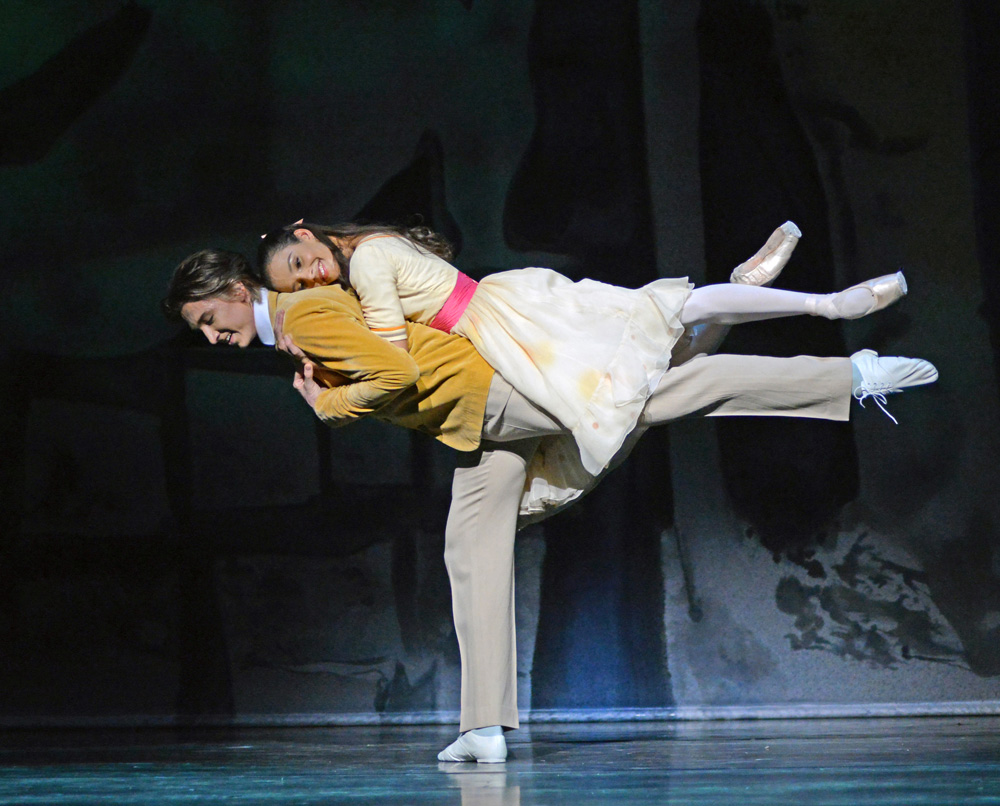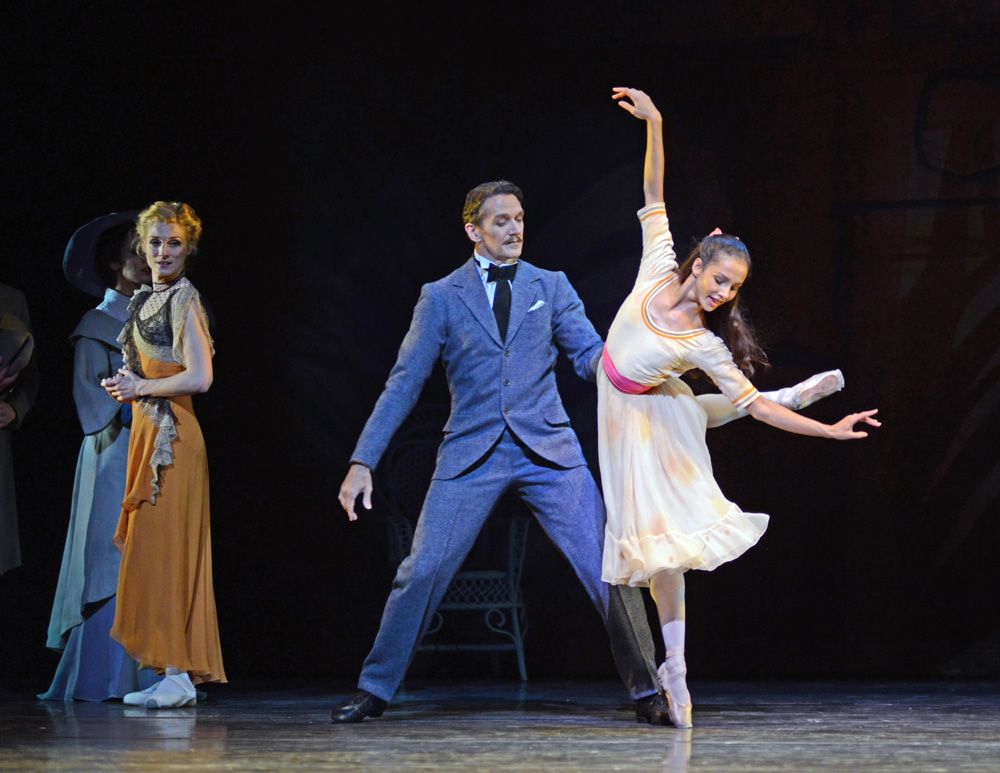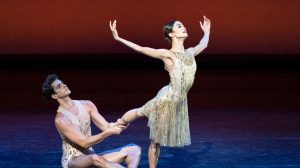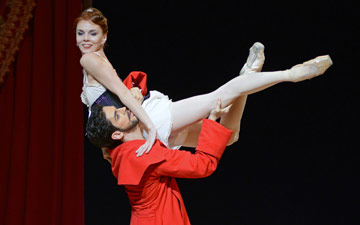
© Dave Morgan, courtesy the Royal Opera House. (Click image for larger version)
Royal Ballet
Obsidian Tear, The Invitation, Within the Golden Hour
★★★★✰
London, Royal Opera House
28 May 2016
Gallery of pictures by Dave Morgan
www.roh.org.uk
Wayne McGregor’s new Obsidian Tear is his Rite of Spring, set to recent music by Esa-Pekka Salonen (who conducted Stravinsky’s Rite at the Festival Hall earlier this month). The ballet’s title refers to a Native American legend about a tribe of warriors forced over a cliff, choosing to die rather than be defeated. The tears shed by their loved ones solidified into black volcanic droplets. Obsidian shards were also used as cutting tools in ritual sacrifices, tearing flesh apart.
McGregor’s drama responds to Salonen’s dark, disturbing music instead of simply using it as a background score. The ballet starts with a sustained duet for two men, Calvin Richardson and Matthew Ball, to a 10-minute violin solo, Lachen verlent, played by Vasko Vassilev. The stage is bare, a vast wooden arena shrouded in darkness. Richardson (who came to prominence as a student in his own version of the Dying Swan) is costumed in flaring red trousers, Ball in black. They look like martial arts combatants, but their encounters range ambivalently from fierce to tender.

© Dave Morgan, courtesy the Royal Opera House. (Click image for larger version)
As the violin swells from calm to frantic sobbing and wailing, the choreography builds from sinuous rippling of the torso to wild leaps and flying lifts. In a sudden resolution to their semi-amorous duel, the two men walk off calmly together, Ball’s arm over Richardson’s shoulder.
The orchestra takes over for Salonen’s Nyx, a symphonic tribute to the ancient Greek goddess of night, nihilism and atavistic urges. Edward Watson enters as a martial arts master, accompanied by six male acolytes, all in black. Costume credits for track pants, vests, body band and kilt go to fashion designers. A ‘shirt dress’ worn by Watson is an unfortunate choice by the Fashion Director, Kate Shillingford. Lucy Carter’s atmospheric lighting makes bare upper bodies gleam in the gloom as dancers waiting their turn sit with their backs to the audience.

© Dave Morgan, courtesy the Royal Opera House. (Click image for larger version)
McGregor’s choreography for his tribe of men develops a language that combines male and female ballet steps and partnering conventions, along with his own delight in unusual undulating spines and arms. He doesn’t analyse the music so much as surf with it, sending the men leaping or spinning like dervishes. He has moved on from fractured acrobatic flailing to far more fluent movement, following the music’s repeats rather than coming up with yet more inventions. Instead of multiple duets, he enables the audience to focus on emerging relationships, as outsider Richardson in red is challenged by the black-clad gang.
Watson and Eric Underwood have a strange, erotic duet to a clarinet solo, caressing each other and taking it in turns to be carried like youngsters. Paul Kay, with black armbands, dances an outstanding solo before grappling with Watson. Alliances shift in this male community of friends and rivals. All nine line up at the front of the stage, treading a glowing orange strip of light. Richardson becomes the sacrificial victim, manhandled into being thrown down a volcanic chasm that opens at the rear of the stage.
Distraught Ball is consoled, in vain, by Watson in an extraordinary, overwrought duet before choosing to follow Richardson into the pit. McGregor acknowledges the contribution of a dramaturg, Uzma Hameed, in devising this dramatic arc to Salonen’s full-throttle music. It has taken McGregor to a rewarding appreciation of male power and vulnerability in newly expressive choreography.

© Dave Morgan, courtesy the Royal Opera House. (Click image for larger version)
Salonen is replaced by Tim Murray as conductor of Matyas Seiber’s commissioned score for Kenneth MacMillan’s The Invitation (1960). Although its structure is unwieldy, with too much scene-setting in the first half, the impact of MacMillan’s psychological insights is still compelling. As each character or couple are introduced, their very first steps reveal who they are. The young girl (Francesca Hayward) has big feet that keep giving her away, eager in their rapier sharpness, then gauche and unsure. The married couple who cause such harm (Gary Avis and Zenaida Yanowsky) enter yoked together in an ill-matched partnership, she emotionally needy, he stiffly resistant.
Maybe their marriage is barren, for she is so taken with the youngsters in the first scene, and he is immediately attracted by Hayward’s innocently flirtatious awareness. Apart from the girl’s infatuated cousin (Vadim Muntagirov), the other adolescents are under-age know-alls, meanly mocking. All our sympathies are with the girl – and the undervalued wife.

© Dave Morgan, courtesy the Royal Opera House. (Click image for larger version)
In Yanowsky’s interpretation, however, the wife is not as put-upon as she seems. She is demanding, thwarted, resentful. Her seduction of the boy cousin is a power play, taking what she wants. Muntagirov is too nice to respond as willingly as he should: how could anyone resist Yanowsky? It’s telling that, at the very end, the wife reclaims her husband (now in thrall to her?) and ignores the traumatised girl.
Avis as the husband is brusque with his wife, suppressing his own frustration, and dangerously charmed by the girl’s naivety. The rape scene is horrifically graphic, blaringly scored by Seiber. The man is appalled by what he has done, crouched on the floor as the girl clutches her womb. Hayward cannot yet encompass the girl’s desolation, facing a bleak future as the curtains close. She has been a youngster bourgeoning into sexuality, an enchanting butterfly broken by her pursuer. Hayward has just the right touch of waywardness (and the beautifully arched feet) of the role’s originator, Lynn Seymour.

© Dave Morgan, courtesy the Royal Opera House. (Click image for larger version)
The triple bill ends with a revival of Christopher Wheeldon’s Within the Golden Hour, a suite of dances to Ezio Bosso’s delectable music. Wheeldon displays what classical ballet does best, making the music visual without following it slavishly, turning duets into intimate relationships, uniting the cast of 14 dancers into a community. Muntagirov, bland in The Invitation, is witty with Beatriz Stix-Brunell in the quirky waltz duet; Lauren Cuthbertson and Matthew Golding dreamy in the ‘Hebridean’ pas de deux; and Sarah Lamb with Steven McCrae luscious in last duet to the andante from Vivaldi’s violin concerto.
It’s an oddly assorted programme that requires very different emotional responses to its three parts. The range of roles shows the Royal Ballet dancers, up-and-coming soloist, established principals and character artists, at their very best.

















You must be logged in to post a comment.